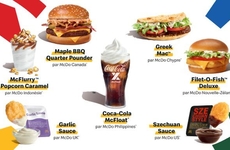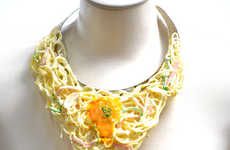
Pasta for Italy, Raw Tuna for Japan and Blue Cheese and Grapes for France
Bianca — September 10, 2009 — Art & Design
References: adsoftheworld & theworldsbestever
These lovely works of art are a delicious twist on edible culture. The food flags shown here are not only astonishingly accurate depictions of national flags from around the world, but they're also created using dishes popular dishes from those parts.
The food flags featured here include Italy (made of basil, plain spaghetti and fresh tomatoes), Japan (a white plate with nothing but a circular cut of raw tuna nigiri), France (made of blue cheese, brie and red grapes), India (curry, rice and spinach), Greece (olives and feta), Switzerland (prosciutto and -- what else? -- Swiss cheese), Korea ( kimbap rolls), Vietnam (litchis and starfruit) and Spain (rice and sausages).
The food flags are part of an ad series promoting the Sydney International Food Festival, a creation of WHYBIN/TBWA, Australia.
The food flags featured here include Italy (made of basil, plain spaghetti and fresh tomatoes), Japan (a white plate with nothing but a circular cut of raw tuna nigiri), France (made of blue cheese, brie and red grapes), India (curry, rice and spinach), Greece (olives and feta), Switzerland (prosciutto and -- what else? -- Swiss cheese), Korea ( kimbap rolls), Vietnam (litchis and starfruit) and Spain (rice and sausages).
The food flags are part of an ad series promoting the Sydney International Food Festival, a creation of WHYBIN/TBWA, Australia.
Trend Themes
1. Edible Flags - Creating national flags with popular dishes offers an opportunity for food branding and cultural fusion.
2. Food Artistry - Incorporating food into creative advertising and marketing appeals to foodies and art enthusiasts alike.
3. Cultural Representation - Using national dishes to create flags implies cultural representation and the promotion of global food diversity.
Industry Implications
1. Food and Beverage - Creating edible flags can be an innovative way to advertise and showcase national cuisine to a wider audience.
2. Advertising - Incorporating food artistry in ad campaigns can be a disruptive innovation in the advertising industry as it appeals to both foodies and art enthusiasts.
3. Tourism - Food is an integral part of tourism, and food flags can promote national dishes to attract tourists interested in experiencing unique cuisine.
4.3
Score
Popularity
Activity
Freshness























